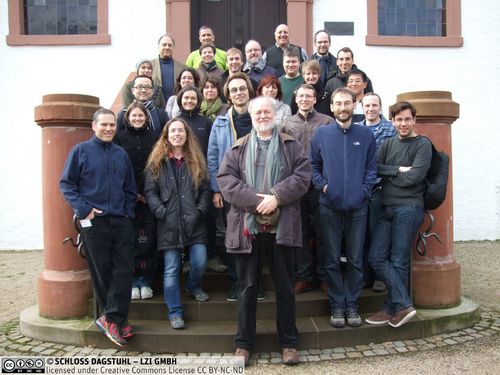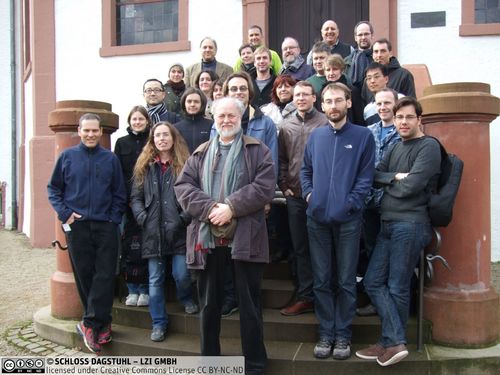Dagstuhl Seminar 14072
New Perspectives in Shape Analysis
( Feb 09 – Feb 14, 2014 )
Permalink
Organizers
- Michael Breuß (BTU Cottbus, DE)
- Alfred M. Bruckstein (Technion - Haifa, IL)
- Petros Maragos (National Technical University of Athens, GR)
- Stefanie Wuhrer (Universität des Saarlandes, DE)
Contact
- Annette Beyer (for administrative matters)
Impacts
- Perspectives in Shape Analysis - Breuß, Michael; Bruckstein, Alfred M.; Maragos, Petros; Wuhrer, Stefanie - Heidelberg : Springer, 2016. - XVII, 370 S. - (Mathematics and visualization). ISBN: 978-3-319-24724-3.
Schedule
Over the last decade, it has become increasingly affordable to digitize 2D and 3D shape information using multiple modalities, such as (video) cameras, image-based reconstruction systems, laser-range scanners, or depth cameras. If these dense models can be processed and described in an efficient and informative way, they can be used in applications, such as ergonomic design, virtual shopping, scientific and medical visualization, realistic simulation, photo-realistic rendering, the design of natural user interfaces, and semantic scene understanding.
Traditionally, the notion of shape has been studied either by analyzing projections of shapes in images or by analyzing a sparse set of marker positions on 3D shapes. Typical tasks in 2D shape analysis include segmenting objects in images and tracking objects across a sequence of images, and typical tasks in 3D shape analysis include reconstructing the three-dimensional object depth from input images and identifying corresponding points on different 3D models. The analysis and processing of shape data becomes especially challenging because of the increasing amount of data captured by sensors used to acquire shapes, and because modern applications such as natural user interfaces require real-time processing of the input shapes.
Meeting these challenges requires models of shape analysis that are compact and informative, thereby allowing the development of algorithms that can process large datasets efficiently. To achieve these goals, interdisciplinary approaches are needed that use concepts from a variety of research areas, including numerical computing, differential geometry, deformable shape modeling, sparse data representation, and machine learning. On the algorithmic side, many shape analysis tasks are modeled using partial differential equations, which can be solved using tools from the field of numerical computing. The fields of differential geometry and deformable shape modeling have recently begun to influence shape analysis methods. Furthermore, tools from the field of sparse representations, which aim to describe input data using a compressible representation with respect to a set of carefully selected basis elements, have the potential to significantly reduce the amount of data that needs to be processed in shape analysis tasks. The related field of machine learning offers similar potential.
The goal of this seminar is to bring together researchers engaged in recent and upcoming developments in shape analysis who view these challenges from different perspectives and who together can identify the pressing open problems and novel solutions to them. Seminar participants will include experts as well as young researchers in both discrete and continuous-scale modeling and computing. The long term goal of this seminar is to form an interdisciplinary research community which works together to identify and address the main challenges in shape analysis.
Dagstuhl seminar 14072 New Perspectives in Shape Analysis took place February 9-14, 2014. 28 researchers from North America and Europe discussed state-of-the-art, current challenges, and promising future research directions in the areas of 2-D and 3-D shape analysis from a cross-disciplinary point of view. Participants included international experts from the fields of continuous-scale shape analysis, discrete shape analysis and sparsity, and numerical computing. The seminar consisted of an opening session, 11 scientific presentation sessions, as well as a break-out session, which provided room for in-depth discussions in small groups. Furthermore, there was time for extensive discussions both between the talks and in the evenings.
This seminar was motivated by the observation that in everyday life, geometric shapes surround us, and that the understanding of concepts describing these shapes is at the heart of various applications, such as ergonomic design, virtual shopping, scientific and medical visualization, realistic simulation, the design of natural user interfaces, and semantic scene understanding. Traditionally, the notion of shape has been studied either by analysing a sparse set of marker positions on 3-D shapes, mostly for medical imaging applications, or by analysing projections of shapes in 2-D images, mostly for image processing and computer vision applications. New challenges in the analysis and processing of such data arise with the increasing amount of data captured by sensors used to acquire shapes, and with modern applications such as natural user interfaces that require real-time processing of the input shapes. Recently, it has become increasingly affordable to digitise 3-D shapes using multiple modalities, such as laser-range scanners, image-based reconstruction systems, or depth cameras like the Kinect sensor. Using these dense 3-D shapes in the above mentioned applications requires processing and describing the shapes in an efficient and informative way.
The purpose of this seminar was to address these challenges with the latest tools related to geometric, algorithmic and numerical concepts. To do so, we brought together researchers working on shape analysis topics from different perspectives.
As the analysis of 3-D shapes and deformable shape models have received much interest recently, classic shape analysis tools from differential geometry have a fresh influence in the field. Being related to the issue how to represent shapes efficiently, the research areas of sparse data representation and machine learning have begun to influence shape analysis modelling and the numerics. Especially in the context of three-dimensional data (or even higher-dimensional data sets), efficient optimization methods will certainly become increasingly important since many shape analysis models can be cast in the form of an optimization problem.
While the fields of modelling and numerical computing are strongly related when it comes to shape analysis applications, modelling is seen as a hot topic in computer science while numerical computing is often seen as a mathematical domain. The purpose in bringing together researchers from those different communities sharing substantial interest in shape analysis was to explore the benefits of a cross-disciplinary point of view. More specifically,
- researchers in continuous-scale shape analysis brought to the meeting their knowledge of differential and variational models and also of classic numerical methods in the field,
- researchers in discrete shape analysis and sparsity brought to the meeting their knowledge about the latest techniques in efficient data representations and related machine learning techniques, as well as efficient data structures and discrete optimization methods, and
- researchers in numerical computing brought to the meeting their knowledge of numerical techniques for PDEs and optimization.
As the demands in the individual fields are high, the research groups in which the most interesting techniques are proposed are quite specialised. This not only holds for discrete and continuous-scale modelling and numerical computing, but also for the areas of sparsity and machine learning that were discussed during this seminar. Because of this, there is no regular conference or workshop that serves as a meeting place for an exchange of ideas of these groups.
Promising new ways to combine the latest techniques from these different fields were identified during in-depth discussions in small groups. Some especially promising research directions in the areas of intrinsic structure detection, co-segmentation of shapes, shape from shading, modelling deformable shapes, and models for face shapes, were discussed in small groups during the break-out session.
 Michael Breuß, Alfred M. Bruckstein, Petros Maragos, and Stefanie Wuhrer
Michael Breuß, Alfred M. Bruckstein, Petros Maragos, and Stefanie Wuhrer
- Mirela Ben-Chen (Technion - Haifa, IL) [dblp]
- Sébastien Bougleux (Caen University, FR) [dblp]
- Michael Breuß (BTU Cottbus, DE) [dblp]
- Alex M. Bronstein (Tel Aviv University, IL) [dblp]
- Michael M. Bronstein (University of Lugano, CH) [dblp]
- Alfred M. Bruckstein (Technion - Haifa, IL) [dblp]
- Leila De Floriani (University of Genova, IT) [dblp]
- Anastasia Dubrovina (Technion - Haifa, IL) [dblp]
- Maurizio Falcone (Sapienza University of Rome, IT) [dblp]
- Anna Hilsmann (HU Berlin, DE) [dblp]
- Yong Chul Ju (TU Cottbus, DE) [dblp]
- Margret Keuper (Universität Freiburg, DE) [dblp]
- Ron Kimmel (Technion - Haifa, IL) [dblp]
- Iasonas Kokkinos (Ecole Centrale - Paris, FR) [dblp]
- Aritom Kovnatsky (University of Lugano, CH) [dblp]
- Petros Maragos (National Technical University of Athens, GR) [dblp]
- Gerlind Plonka-Hoch (Universität Göttingen, DE) [dblp]
- Martin Rumpf (Universität Bonn, DE) [dblp]
- Frank R. Schmidt (Universität Freiburg, DE) [dblp]
- Carola-Bibiane Schönlieb (University of Cambridge, GB) [dblp]
- William Smith (University of York, GB) [dblp]
- Sibel Tari (Middle East Technical University - Ankara, TR) [dblp]
- Silvia Tozza (Sapienza University of Rome, IT) [dblp]
- Matthias Vestner (TU München, DE) [dblp]
- Martin Welk (UMIT - Hall in Tirol, AT) [dblp]
- Stefanie Wuhrer (Universität des Saarlandes, DE) [dblp]
- Hao (Richard) Zhang (Simon Fraser University - Burnaby, CA) [dblp]
- Jovisa Zunic (University of Exeter, GB) [dblp]
Related Seminars
Classification
- computer graphics / computer vision
Keywords
- Shape analysis
- mathematical morphology
- shape reconstruction
- sparsity
- machine learning
- numerical computing
- level set methods
- optimization methods



 Creative Commons BY 3.0 Unported license
Creative Commons BY 3.0 Unported license
